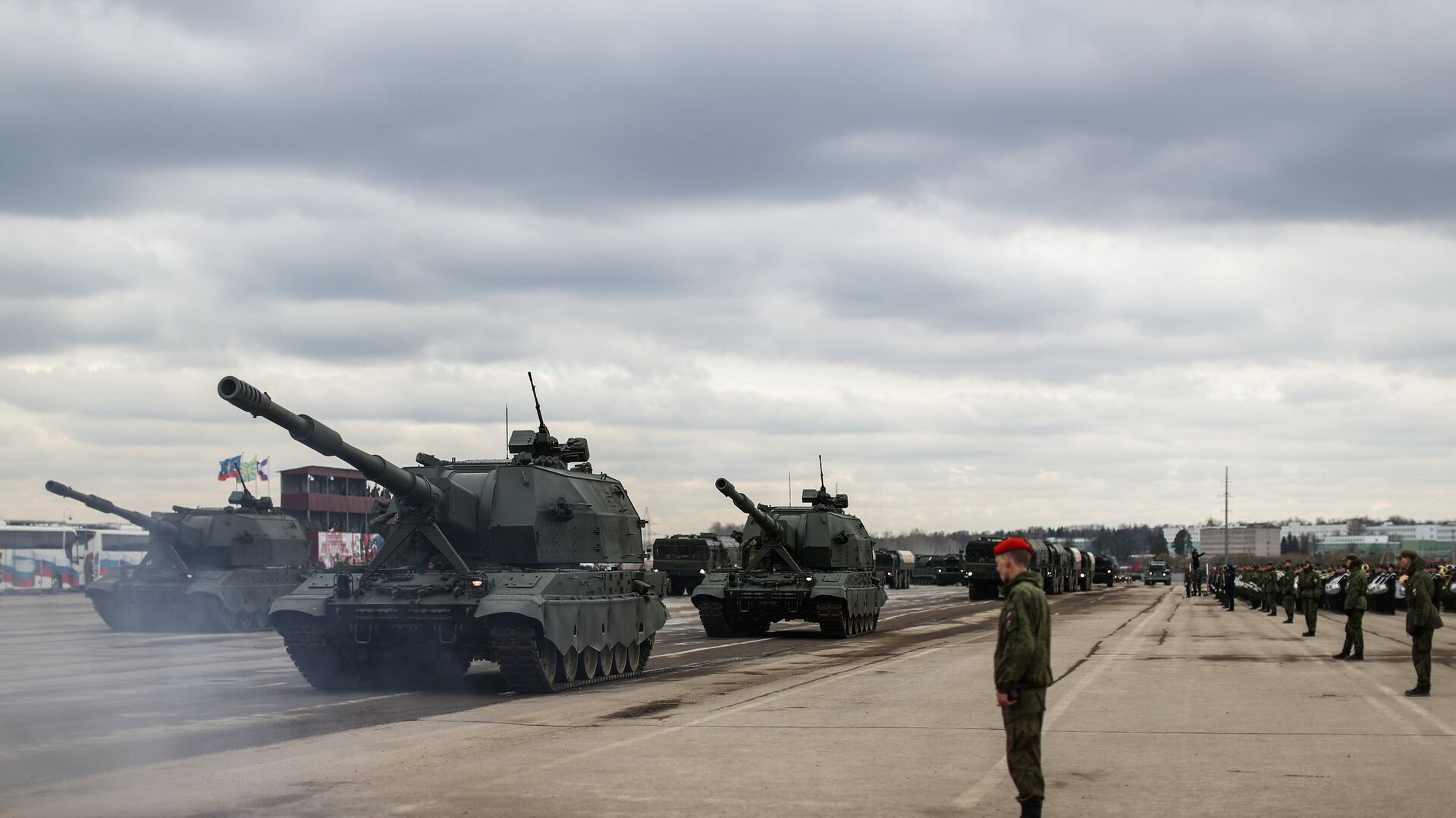https://sputnikglobe.com/20231028/koalitsiya-sv-russias-cutting-edge-self-propelled-artillery-ready-to-redefine-conflict-1114549336.html
Koalitsiya-SV: Russia's Cutting-Edge Self-Propelled Artillery Ready to Redefine Conflict
Koalitsiya-SV: Russia's Cutting-Edge Self-Propelled Artillery Ready to Redefine Conflict
Sputnik International
Russian industry is preparing for the mass production of a critical system - the ‘Koalitsiya-SV’ self-propelled gun. This type of weapon has qualities that could dramatically change the situation on the front lines. However, before the manufacturers can move forward, there are several crucial tasks to be accomplished.
2023-10-28T14:55+0000
2023-10-28T14:55+0000
2023-10-28T14:55+0000
russia's special operation in ukraine
russia
kiev
nato
lancet
koalitsiya-sv
t-90
ukraine
ukrainian counteroffensive attempt
https://cdn1.img.sputnikglobe.com/img/103851/92/1038519230_0:105:3267:1942_1920x0_80_0_0_522418b4772456f8299eea7df5d4fcfe.jpg
Military personnel and analysts have repeatedly noted that Russian artillery lags behind its NATO counterpart in several key respects, most notably in range.This does not mean, however, that Russia has nothing to counter Western weapons. Unmanned aerial vehicles (UAVs), both reconnaissance and strike, play an important role in counter-battery warfare, often combining both functions.Recently, Yuriy Fedorenko, commander of the 92nd Separate Mechanized Brigade of the Ukrainian Armed Forces, complained about the advantage of Russian forces in this area.Lancet extended-range loitering munitions are particularly effective, hitting targets up to 50 kilometers away, with newer versions reaching up to 70 kilometers.Koalitsiya-SV ComplexHigh hopes are pinned on the Koalitsiya-SV (lit. Coalition-SV), which has an effective range of 70-80 kilometers.Its rate of fire exceeds 10 rounds per minute (some reports claim up to 16 rounds per minute), setting a record for self-propelled howitzers.The system is highly automated, often referred to as a "combat robot," as described by Bekhan Ozdoev, the industrial director of Rostec's Armaments, Ammunition, and Special Chemicals Cluster.A crew of three men (commander, driver-mechanic, and gunner) manages the firing while isolated inside an armored capsule. The turret, which holds 70 rounds of ammunition, is mounted on the chassis of a T-90 tank.The Rostec State Corporation has already successfully completed state testing of the vehicle, confirming all of its unique features, Ozdoev said.World's Biggest Twin-Barrel GunThe history of self-propelled artillery dates back to the era of the arms race, when the Western and Eastern blocs competed in range and rate of fire of artillery guns.The self-propelled gun was originally named "Koalitsiya" due to its twin-barrel design, designed to achieve high fire rates. However, this design was considered too unreliable. It was also claimed that similar characteristics could be achieved with a single barrel.The new vehicle was first unveiled at the Victory Day parade in 2015. Five years later, several units were introduced into the military. As for the use of the Koalitsiya-SV in the Ukraine conflict, there is no available information.There is one caveat, however. Despite having a standard Russian artillery caliber of 152 millimeters, the self-propelled artillery cannot use Soviet-era ammunition, which is stored and produced in large quantities in the country.The Koalitsiya relies on a special type of ammunition to achieve extended ranges. Now the defense sector is quickly establishing the production of new ammunition.However, the success of counter-battery engagements depends not only on guns, but also on high-quality intelligence and reliable communications. Russia, for example, uses state-of-the-art radar systems.It should be noted that assessments of the results of counter-battery warfare are often subjective. For understandable reasons, neither side discloses casualty data. The effectiveness of artillery can be judged from the overall situation on the front lines, where, despite Kiev's claims, the long-awaited "breakthroughs" have failed to materialize.
https://sputnikglobe.com/20230810/russias-rostec-quadruples-armored-vehicle-production--1112500006.html
https://sputnikglobe.com/20230609/watch-russian-artillery-obliterate-ukrainian-self-propelled-howitzer-1111021988.html
russia
kiev
ukraine
Sputnik International
feedback@sputniknews.com
+74956456601
MIA „Rossiya Segodnya“
2023
Andrey Kots
https://cdn1.img.sputnikglobe.com/img/07e7/09/0d/1113345217_428:0:2132:1704_100x100_80_0_0_572c3cfc2b7e5fdab0f340359bd4760b.jpg
Andrey Kots
https://cdn1.img.sputnikglobe.com/img/07e7/09/0d/1113345217_428:0:2132:1704_100x100_80_0_0_572c3cfc2b7e5fdab0f340359bd4760b.jpg
News
en_EN
Sputnik International
feedback@sputniknews.com
+74956456601
MIA „Rossiya Segodnya“
Sputnik International
feedback@sputniknews.com
+74956456601
MIA „Rossiya Segodnya“
Andrey Kots
https://cdn1.img.sputnikglobe.com/img/07e7/09/0d/1113345217_428:0:2132:1704_100x100_80_0_0_572c3cfc2b7e5fdab0f340359bd4760b.jpg
russia's cutting-edge self-propelled artillery, ‘koalitsiya-sv, self-propelled gun
russia's cutting-edge self-propelled artillery, ‘koalitsiya-sv, self-propelled gun
Koalitsiya-SV: Russia's Cutting-Edge Self-Propelled Artillery Ready to Redefine Conflict
Russian industry is preparing for the mass production of a significant system - the Koalitsiya-SV self-propelled gun. This type of weapon has qualities that could dramatically change the situation on the front lines. However, before the manufacturers can move forward, there are several crucial tasks to be accomplished.
Military personnel and analysts have repeatedly noted that Russian artillery lags behind its NATO counterpart in several key respects, most notably in range.
This does not mean, however, that Russia has nothing to counter Western weapons. Unmanned aerial vehicles (UAVs), both reconnaissance and strike, play an important role in counter-battery warfare, often combining both functions.
Recently, Yuriy Fedorenko, commander of the 92nd Separate Mechanized Brigade of the Ukrainian Armed Forces, complained about the advantage of Russian forces in this area.
"FPV drones remain on standby until our vehicles, firepower or something else comes into view, and then they attack," he told Ukrainian media.
Lancet extended-range loitering munitions are particularly effective, hitting targets up to 50 kilometers away, with newer versions reaching up to 70 kilometers.
High hopes are pinned on the Koalitsiya-SV (lit. Coalition-SV), which has an effective range of 70-80 kilometers.
Its rate of fire exceeds 10 rounds per minute (some reports claim up to 16 rounds per minute), setting a record for self-propelled howitzers.
The system is highly automated, often referred to as a "combat robot," as described by Bekhan Ozdoev, the industrial director of Rostec's Armaments, Ammunition, and Special Chemicals Cluster.
A crew of three men (commander, driver-mechanic, and gunner) manages the firing while isolated inside an armored capsule. The turret, which holds 70 rounds of ammunition, is mounted on the chassis of a
T-90 tank.
The Rostec State Corporation has already successfully completed state testing of the vehicle, confirming all of its unique features, Ozdoev said.

10 August 2023, 12:51 GMT
World's Biggest Twin-Barrel Gun
The history of self-propelled artillery dates back to the era of the arms race, when the Western and Eastern blocs competed in range and rate of fire of artillery guns.
The
self-propelled gun was originally named "Koalitsiya" due to its twin-barrel design, designed to achieve high fire rates. However, this design was considered too unreliable. It was also claimed that similar characteristics could be achieved with a single barrel.
The new vehicle was first unveiled at the Victory Day parade in 2015. Five years later, several units were introduced into the military. As for the use of the Koalitsiya-SV in the Ukraine conflict, there is no available information.
There is one caveat, however. Despite having a standard Russian artillery caliber of 152 millimeters, the self-propelled artillery cannot use Soviet-era ammunition, which is stored and produced in large quantities in the country.
The Koalitsiya relies on a special type of ammunition to achieve extended ranges. Now the defense sector is quickly establishing the production of new
ammunition.
However, the success of counter-battery engagements depends not only on guns, but also on high-quality intelligence and reliable communications. Russia, for example, uses state-of-the-art radar systems.
It should be noted that assessments of the results of counter-battery warfare are often subjective. For understandable reasons, neither side discloses casualty data. The effectiveness of artillery can be judged from the overall situation on the front lines, where, despite Kiev's claims, the long-awaited "breakthroughs" have failed to materialize.





